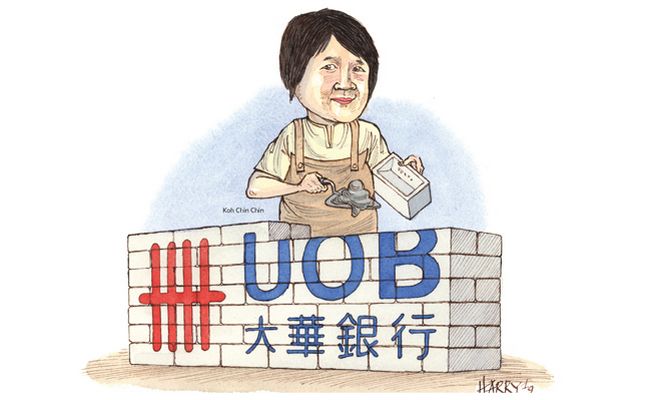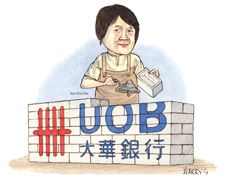Profile building
After revamping its approach to wholesale funding, one bank furthered its reputation in 2019 as a committed and consistent issuer across the local and global capital markets. For its long-term thinking and exemplary execution, United Overseas Bank is IFR Asia’s Issuer of the Year.

United Overseas Bank built on its reputation as one of Asia’s top capital markets issuers in 2019 with a series of smartly timed financings that spanned multiple markets and the entire capital structure.
It opened up new markets with Singapore’s first Panda bond, set new benchmarks for bank capital and reopened the covered bond market for Singaporean banks. The bank raised US$2.3bn-equivalent in IFR Asia’s review period, and found ways to engage with investors even when conditions were not right for a new issue.
UOB has now firmly established itself as a major frequent issuer in the capital markets, after a strategic shift that began with the creation of the central treasury unit in 2013. From a bank that was little known outside of its home market barely five years ago, it has become a standard-bearer for the Asian banking sector with a series of well-executed deals that have attracted hundreds of investors.
Koh Chin Chin, head of the central treasury unit, oversees funding across all markets and has built a team of bankers who hold themselves to a high standard and are not afraid to challenge the levels they are shown.
UOB remains primarily deposit-funded, but the wholesale issuance strategy has allowed it to diversify its investor base, giving the bank additional comfort in the face of long-term challenges from demographic changes or technology disruption.
The group issued in every quarter of 2019 and was the only Asian bank to issue across the capital stack, with Additional Tier 1, Tier 2, senior and covered bonds all in the market.
It held regular investor updates spanning 21 cities and nearly 180 investor meetings across the US, Europe, Asia and Australia and was well rewarded for its engagement efforts, with consistently tight pricing across all its new issues.
No single deal typified UOB’s long-term approach and its determination to open new markets more than its debut Panda bond.
The Rmb2bn (US$298.2m) three-year, priced in March, was the culmination of almost 18 months of work to establish a foothold in the onshore Chinese market. UOB completed the first stage in 2018, with a smaller Rmb1bn debut from its onshore Chinese subsidiary that created a pricing benchmark and introduced the credit to mainland Chinese investors for the first time.
UOB then held five days of non-deal roadshows in October 2018 in Beijing, Shanghai, Shenzhen and Hong Kong, during which the bank met more than 25 investors. That gave investors time to study the credit and put lines in place once a deal was announced.
The cross-border Panda bond, which requires a different set of regulatory approvals, was the first for a Singaporean issuer, opening an important new market for UOB and others. After a long approval process, UOB waited for the right window in the swap market and was rewarded with a 62% allocation to offshore investors. Pricing came at 3.49%, towards the tight end of a 3.4%–4.0% range and only 35bp back of the local China Development Bank benchmark.
Bank of China was the lead underwriter and lead bookrunner, and China Securities and Standard Chartered Bank were joint lead underwriters and joint bookrunners.
UOB’s work with onshore investors led to another landmark deal at the end of IFR’s review period, when it launched a Tier 2 offering for UOB (China), its onshore subsidiary.
Notably, UOB underlined its commitment to transparency and high standards in the form of an international credit rating from Fitch, the first on a deal of its kind. The Rmb1bn 10-year non-call five Tier 2 bonds went on to price at 4.8%, with around 70% of the deal sold onshore.
“After engaging with onshore Chinese investors, they also looked at other bonds in our capital structure,” said Koh. “We want to help build the Panda market at this early stage.”
GLOBAL PRESENCE
UOB was a repeat issuer in the US dollar market during IFR’s review period, first selling a US$600m Tier 2 in 144A format in April, and later in the year printing a US$500m three-year Reg S covered bond in September.
The two deals were targeted at very different sets of investors, underlining UOB’s commitment to regular issuance in all its strategic markets.
The 10-year non-call five 144A Tier 2 priced at a tight 150bp over Treasuries, or 25bp inside initial price guidance, with a healthy 40% allocation to the US and 25% to Europe. The deal expanded UOB’s 144A investor base, following its inaugural US$1.2bn 144A senior bond in April 2018.
Citigroup, Credit Suisse, HSBC, Standard Chartered and UOB were joint bookrunners.
The covered bond priced to yield 1.73% off a 1.625% coupon, equivalent to mid-swaps plus 32bp, and came at a time when currency swaps meant the bigger euro covered bond market was effectively closed to foreign issuers. By switching to dollars, UOB met its size target and saved around 30bp–35bp compared with senior bond pricing, making effective use of its mortgage collateral pool.
More significantly, it maintained its commitment to the covered bond market and brought in some investors who were new to the credit.
“We are exploring different ways to engage European investors while it’s difficult to issue euro-denominated covered bonds because swap rates are not in our favour,” said Koh.
Europe took 58% of the Reg S bonds and Asia 42%. By investor type, banks booked 68%, central banks 23% and funds 9%.
LOCAL LANDMARK
UOB returned to the Singapore dollar market in style in early July, selling S$750m (US$535m) of perpetual non-call seven securities at 3.58% – the lowest priced Basel III-compliant Additional Tier 1 issue ever in Singapore.
The bank had noticed strong demand for a string of AT1 issues from foreign banks, all of which had performed well, and had the conviction to test a record-low yield.
“We capitalised on a conducive market window to return to the Singapore dollar bond market and engage our domestic investor base,” said Koh. “Despite pricing at untested yield levels, there was strong demand for the issuance, especially from institutional investors.”
The Singaporean bank chose a call after year seven to stagger and optimise its bond maturity profile. UOB was sole global coordinator, as well as joint bookrunner with ANZ, HSBC, Standard Chartered and UBS.
Six days after its Singapore pricing, UOB’s Sydney branch raised A$500m (US$350m) from a three-year floating-rate note at three-month BBSW plus 53bp.
The opportunistic trade came after the Australian Prudential Regulatory Authority, the local banking watchdog, ordered the country’s major banks to ramp up their Tier 2 capital buffers, prompting a rally in senior spreads. UOB was able to price almost flat to the Australian majors and locked in a favourable move in the currency swap. A year earlier UOB Sydney had priced a A$600m 3.5-year floater at a spread of 81bp.
HSBC, NAB, UOB and Westpac were joint lead managers.
“We have been closely monitoring markets and spotted a window
of opportunity with [the] announcement by APRA on Tier 2 securities,” said Koh.
“The strong performance of the issuance reflects the confidence of international investors in UOB’s strong business fundamentals.”
Australian investors bought 87% and Asia 13%. Official institutions were allotted 44%, fund managers and insurance companies 29%, banks 24% and others 3%.
UOB also sold Tier 2 bonds in the Indonesian rupiah market in October, raising Rp650bn (US$43m) of capital for its local operations. That was the first bank capital offering of the year in rupiah, and followed a third rate cut in three months, helping UOB achieve attractive pricing.
UOB’s wholesale financings in 2019 were a combination of long-term strategic trades and quick-fire opportunistic issues, moving the markets forward at the same time as expertly navigating volatile conditions.
To see the digital version of this report, please click here
To purchase printed copies or a PDF, please email gloria.balbastro@refinitiv.com







